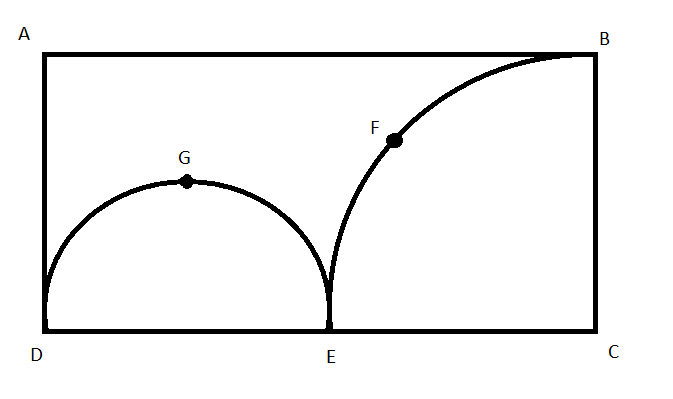
In the figure given below, ABCD is a rectangle. AB = 14 cm, BC = 7 cm. From the rectangle, a quarter circle BFEC and a semi-circle DGE are removed. Calculate the area of the remaining piece of the rectangle. (Take \[\pi = \dfrac{{22}}{7}\])


Answer
582.6k+ views
Hint: First of all, find the radius of the quarter circle as its length equals to its smallest side. Then find the radius of the semi-circle as its diameter is equal to the subtraction of radius of the quarter circle from the larger side of the circle. Finally, the area of the remaining piece of the rectangle is given by the area of the rectangle – area of the semi-circle – area of the quarter circle.
Complete step by step solution:
Given that AB = 14 cm and BC = 7 cm
We know that the area of the rectangle of height \[h\] and base \[b\] is given by \[h \times b\].
So, area of rectangle ABCD \[ = 14 \times 7 = 98{\text{ c}}{{\text{m}}^2}\]
From the given figure, clearly radius of the quarter circle BFEC is 7 cm
We know that the area of the quarter circle of radius \[r\] is given by \[\dfrac{1}{4} \times \dfrac{{22}}{7} \times {r^2}\].
So, area of the quarter circle BEFC \[ = \dfrac{1}{4} \times \dfrac{{22}}{7} \times {\left( 7 \right)^2} = 38.5{\text{ c}}{{\text{m}}^2}\]
From the given figure, we have
Diameter of semi-circle DGE + radius of quarter circle BEFC = 14 cm
Diameter of semi-circle BEFC + 7 cm = 14 cm
Therefore, diameter of semi-circle BEFC = 14 cm – 7 cm = 7 cm.
We know that the radius of a semicircle is given by half of its diameter.
So, radius of the semi-circle BEFC \[ = \dfrac{7}{2}{\text{ cm}}\]
We know that the area of a circle of radius \[R\] is given by \[\dfrac{1}{2} \times \dfrac{{22}}{7} \times {R^2}\].
So, area of the semi-circle BEFC \[ = \dfrac{1}{2} \times \dfrac{{22}}{7} \times {\left( {\dfrac{7}{2}} \right)^2} = 19.25{\text{ c}}{{\text{m}}^2}\]
The area of the remaining piece of rectangle = area of the rectangle ABCD – area of the semi-circle
BEFC – area of the quarter circle DGE
\[
= 98 - 19.25 - 38.5 \\
= 40.25{\text{ c}}{{\text{m}}^2} \\
\]
Thus, the area of the remaining piece of the rectangle is \[40.25{\text{ c}}{{\text{m}}^2}\].
Note: The area of the quarter circle of radius \[r\] is given by \[\dfrac{1}{4} \times \dfrac{{22}}{7} \times {r^2}\]. The area of the rectangle of height \[h\] and base \[b\] is given by \[h \times b\]. The area of a circle of radius \[R\] is given by \[\dfrac{1}{2} \times \dfrac{{22}}{7} \times {R^2}\].
Complete step by step solution:
Given that AB = 14 cm and BC = 7 cm
We know that the area of the rectangle of height \[h\] and base \[b\] is given by \[h \times b\].
So, area of rectangle ABCD \[ = 14 \times 7 = 98{\text{ c}}{{\text{m}}^2}\]
From the given figure, clearly radius of the quarter circle BFEC is 7 cm
We know that the area of the quarter circle of radius \[r\] is given by \[\dfrac{1}{4} \times \dfrac{{22}}{7} \times {r^2}\].
So, area of the quarter circle BEFC \[ = \dfrac{1}{4} \times \dfrac{{22}}{7} \times {\left( 7 \right)^2} = 38.5{\text{ c}}{{\text{m}}^2}\]
From the given figure, we have
Diameter of semi-circle DGE + radius of quarter circle BEFC = 14 cm
Diameter of semi-circle BEFC + 7 cm = 14 cm
Therefore, diameter of semi-circle BEFC = 14 cm – 7 cm = 7 cm.
We know that the radius of a semicircle is given by half of its diameter.
So, radius of the semi-circle BEFC \[ = \dfrac{7}{2}{\text{ cm}}\]
We know that the area of a circle of radius \[R\] is given by \[\dfrac{1}{2} \times \dfrac{{22}}{7} \times {R^2}\].
So, area of the semi-circle BEFC \[ = \dfrac{1}{2} \times \dfrac{{22}}{7} \times {\left( {\dfrac{7}{2}} \right)^2} = 19.25{\text{ c}}{{\text{m}}^2}\]
The area of the remaining piece of rectangle = area of the rectangle ABCD – area of the semi-circle
BEFC – area of the quarter circle DGE
\[
= 98 - 19.25 - 38.5 \\
= 40.25{\text{ c}}{{\text{m}}^2} \\
\]
Thus, the area of the remaining piece of the rectangle is \[40.25{\text{ c}}{{\text{m}}^2}\].
Note: The area of the quarter circle of radius \[r\] is given by \[\dfrac{1}{4} \times \dfrac{{22}}{7} \times {r^2}\]. The area of the rectangle of height \[h\] and base \[b\] is given by \[h \times b\]. The area of a circle of radius \[R\] is given by \[\dfrac{1}{2} \times \dfrac{{22}}{7} \times {R^2}\].
Recently Updated Pages
Two men on either side of the cliff 90m height observe class 10 maths CBSE

What happens to glucose which enters nephron along class 10 biology CBSE

Cutting of the Chinese melon means A The business and class 10 social science CBSE

Write a dialogue with at least ten utterances between class 10 english CBSE

Show an aquatic food chain using the following organisms class 10 biology CBSE

A circle is inscribed in an equilateral triangle and class 10 maths CBSE

Trending doubts
Why is there a time difference of about 5 hours between class 10 social science CBSE

Write a letter to the principal requesting him to grant class 10 english CBSE

What is the median of the first 10 natural numbers class 10 maths CBSE

The Equation xxx + 2 is Satisfied when x is Equal to Class 10 Maths

Which of the following does not have a fundamental class 10 physics CBSE

State and prove converse of BPT Basic Proportionality class 10 maths CBSE




